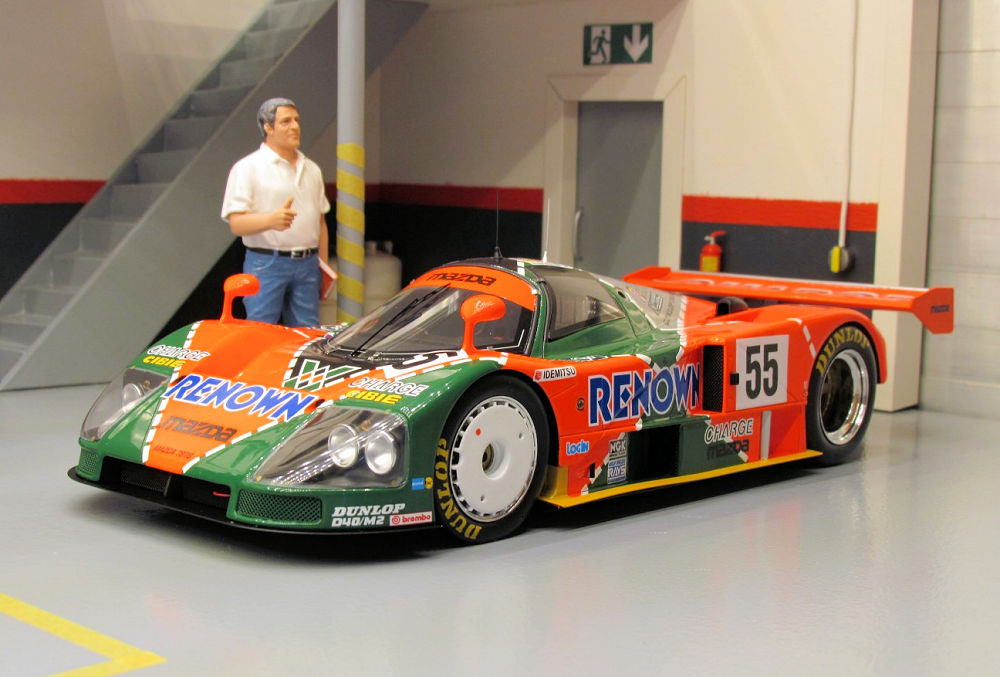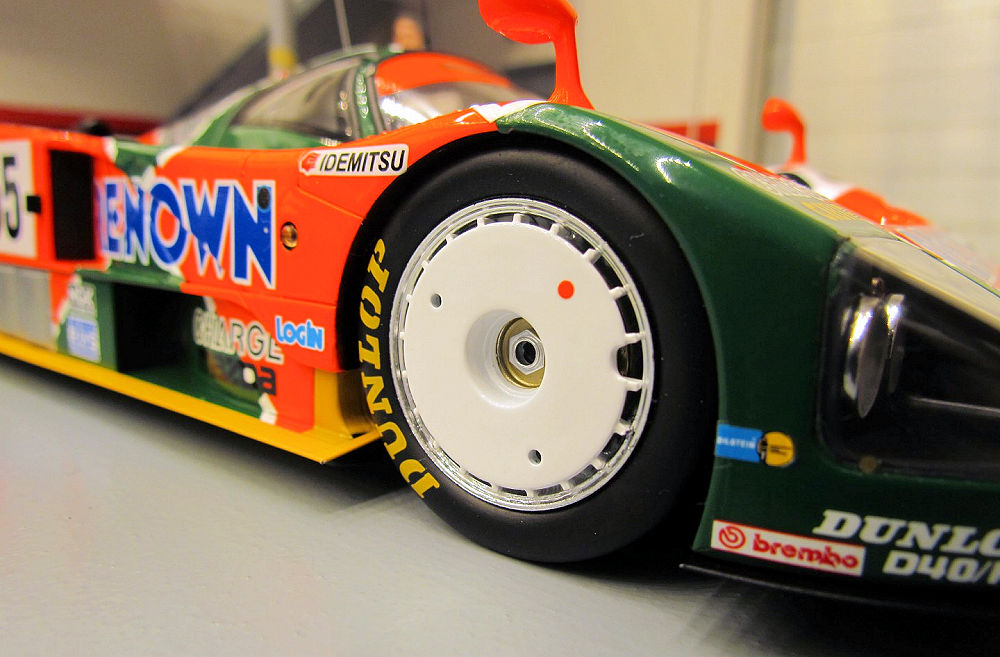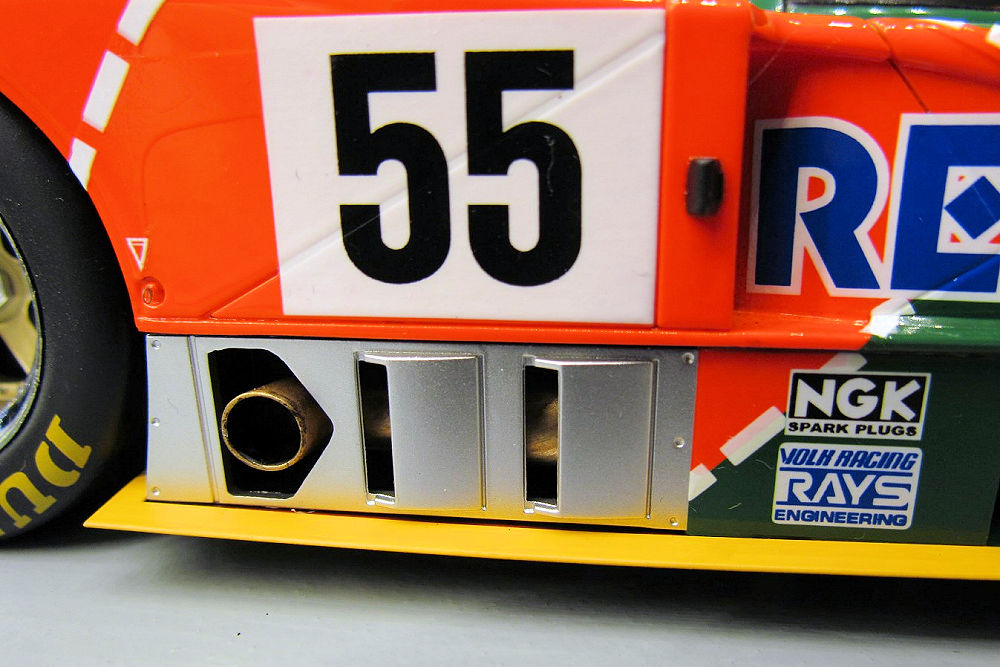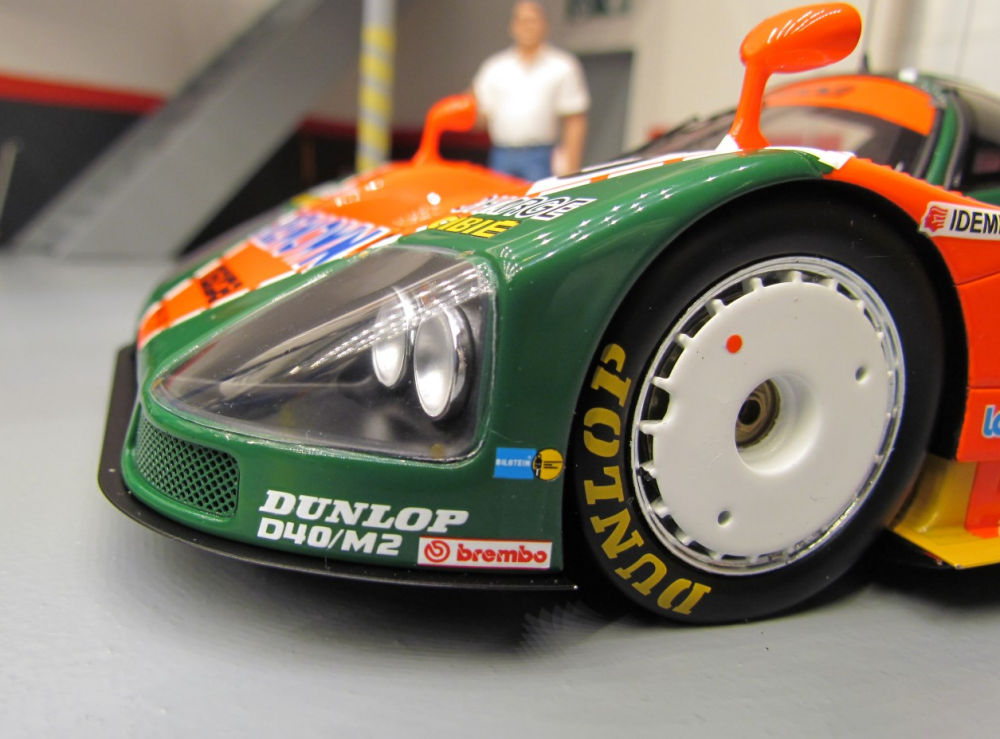Words and photos courtesy of Marcel Slooter
When talking about famous race cars, especially Le Mans 24h cars, one car always comes to mind. The Mazda 787b is the car we are speaking to here. It is famous for a number of reasons, firstly it is the overall winning Group C car from the 1991 Le Mans edition, secondly the first (and until 2018 the only) Japanese Le Mans winning car. But it is most famous for its engine. Still, up to this day, and probably for eternity, it is the only rotary engine to win the notorious 24-hour race in France. And what an engine the 2,6 litre 4 rotor is! If you are not familiar with the sound, please do some research on YouTube. You won’t be disappointed.
The model under the lens here is made by Spark. For collectors unfamiliar with the brand, they make sealed resin models of race and road cars, but with the focus strongly pointing toward race cars, both vintage and modern. The prices (based on the European market) are in the higher mid-range, at just above 150 euros. To compare that to other brands making sealed resin models, that is about 50 euro above the price for a regular GT-Spirit model, but about half the price you would pay for a resin BBR model.

Like all the other Spark models I bought over the years, this model also comes in a cardboard box containing a Styrofoam shell. The model itself is secured to a base plate. As far as I’m aware, most (if not all) Spark models come with a wooden base plate, with some information about the car written on it. The first thing I always do is unscrew the model from that plate, as I display my models without. It is easily done with four screws holding it in place. The model is quite heavy, so make sure to hold it firmly while doing this and prevent dropping it. Spark tightened the screws a bit too tight, leaving the tyres of the car somewhat flattened. No big deal, the wheels don’t turn on this Spark model, so it is not noticeable when on display.

The most important part of a sealed model is of course the exterior. As nearly all the attention of the brand goes to the exterior, one should expect solid execution without compromise. I never have been disappointed with a model made by Spark and neither this time. The first impression when freeing the model from its box is that of a crisp and well-defined replica.
Let’s take a look at the paint first. The model basically has two colours, one is dark green and the other the very contrasting orange. Both obviously due to the sponsor Renown. Where most model makers would spray the model one colour and add the other with decals, Spark went the more refined route and spray painted both colours. The paint is applied perfectly, not a single disturbance is visible and the shine is as it should be.

Being a race car, it is a given that there are plenty of sponsor names on the car. Spark choose, as always, to use waterslide decals for this part of the model. They are applied with care and straight as an arrow. Also, the placement of the white ‘stitching’ is without fault. One little point of criticism is that Spark doesn’t cover the decals with a clear coat of paint. Brands like Kyosho and AUTOart do that as standard nowadays. It would certainly help over time as decals tend to get brittle and sometimes come off. So a piece of advice is to handle this model with the collector gloves on, especially when it gets older.
On to the shape and stance of the model. When comparing to photographs of the real car, the shape seems to be spot on. Also, the dimension of the model is absolutely spot on with the real car. I looked up the dimensions of the 787b, divided them by 18 and measured the model. The wheelbase, axle width, length, height and width of the car are very accurate. Unfortunately in the model car world, it is not a given that these factors are spot on, so well done Spark! The stance of the model looks slightly off when looking at photo’s, as it looks like the front of the car is a little too high from the ground. The problem seems to lie in the tyres, but more on that later. Apart from the front height, the stance is good.
Looking at the ‘panel gaps’ they are perfect. But, one should expect nothing less from a sealed resin model.

The next items to inspect are the wheels and tyres. They look is excellent, crisp and with the use of good colours. The front wheels are different on the 787b throughout different stages in its life, but accurate to the specific race this car is based on. The same goes for the tyres. In a lot of photos of the real car, the branding on the tyres is different, but after some research, it seems Spark has it spot on. The car had different tyre branding in this race (only one time Dunlop instead of two times per tyre). Just like the car itself I measured the dimensions of the wheels and tyres. The wheels are exactly 18 inches, like on the real deal. The rear tyres are also spot on, but the front tyres are 1,5mm to large in diameter. This is the reason the front looks a bit on the high side. Behind the rear wheels, the brakes look good, with a tiny decal on the callipers and good use of paint. At the front, it is, both from the inside and outside, impossible to see the brakes due to the wheel design.

Let take a look at the exterior details, like for instance the vents. And, being a high power race car, there are a lot of them. We see a mixture of open and solid vents here as the pictures will show. At the very front, the middle grill is solid black, the small grills in the green bodywork under the headlights are perforated. The same goes for the massive cooling opening in front of the windscreen. If you look closely, and with the correct lighting, you will spot a radiator deep down there. Very nice. Moving further back, the vents above the wheels arches are closed. So are all the grills on both sides of the model, as they are all made of solid plastic. The vents on the engine cover are all open and show radiators behind. Also, the air intakes of the engine appear open, or at least the end of those tunnels are not visible, because of them being very narrow and deep. The last opening to take a look at is the area around the exhaust. This is all open, making the exhaust visible before it sticks out of the side of the car. The exhaust and the surrounding area are very carefully executed.

Being a 24-hour race car, the car obviously has to have some lights as it will also race at night. The front lights look simple, but so are the ones of the real car. Race car designers don’t go for the fanciest looking design. It should be functional, nothing more. Spark replicated them perfectly, no complaints here. The rear lights are even more basic, being tucked away under the massive rear wing. Also, these are replicated to the original.

While we’re looking at the rear of the car, let’s take a look at what else is present. Most obvious is the massive rear wing. The wing, including its supports, is beautifully made by Spark. The supports for the jack (in order to lift the car during pit stops) are also present. Under the rear wing, at the edge of the rear body panel is a small gurney flap. This is a little metal photo edged piece and looks very nice. Going further down, we arrive at the massive diffuser. Being a real ‘ground effect’ car, this diffuser is really massive! It is part of the model’s bottom plate and therefore made of resin. It is also pretty thin, so be careful not to bump it into something, as it will undoubtedly break. The diffuser is finished, like the original, in matt black. In between the wing and the diffuser the back of the gearbox is visible. The rest under the rear bodywork is blocked off, the downside of a sealed model.
Moving towards the front of the model, we come across some other exterior bits worth mentioning. Things like the antennas, mirrors, sidelights, fuel cap, tow hook, skirts, body panel releases buttons and so on, are all very accurate and delicately made. Special mention goes to the windscreen, the wiper and the little brackets that hold the windows in place. Beautiful, tiny, photo edged parts.

Most of the time a resin model comes with a basic interior. This time it is not the most detailed I have ever seen, but it’s not as basic as with some other brands making sealed models. It is nearly impossible to see and to take a picture of the interior, due to the size of the windows and the dark nature of the interior. But when looking carefully with a flashlight in one hand, the interior seems to look decent. The dashboard looks okay, with all the switches present. Also, the instrument panel with the rev counter looks crisp. It took me a long time to spot, but in the footwell, there is a red fire extinguisher (impossible to get on a photo). The seat looks good and is equipped with a full 6 point harness, which is finished with photo edged parts. The only negative is the very plastic-looking steering wheel.
So what do I think of Spark’s take on the Mazda 787b? As mentioned earlier I’m not disappointed. It is in line with the Spark models I bought in the last couple of years. And of course, being disappointed or happy with a product is nothing more than getting or not getting what you expected. For the collectors which don’t have the Spark model (yet), this Mazda 787b is a fine specimen. It has many, many strong points, especially when it comes to exterior details and paint. For me, the two biggest negatives about this model are the front tyres and the use of too many solid grills. The first one should have been better, the second one is part of being a sealed model. Making perforated grill everywhere would mean fabricating parts that go behind each grill. That would have undoubtedly raised the price.

Do I recommend this model? Yes. Are there alternatives? Also yes. As far as I know, there are two other manufacturers that have made this 787b. The first is AUTOart, which is pretty rare and goes for prices up to 5 times what I paid for this Spark model. It is however one of the best models ever made by AUTOart. The second alternative is the recently released CMR model. However, it is not a replica of the real Le Mans car, but of a show car, having different front wheels. That model is in a lower price range and has opening doors. I haven’t seen that one in the flesh yet, but no doubt it won’t match the Spark in exterior details. Which one you should prefer is all up to you. Happy collecting!



















Thank you for sharing the review, excellent detail! Seems Spark got most on the details right… Based on their price clear coated decals would be nice. Main reason why I stopped collecting race cars, the peeling decals! Also, the lack if mesh grilles is another bone of contention, being sealed you need to provide as much exterior detail as possible. In the end, still a cost effective alternative to AUTOart.
I have both the AutoArt and the CMR model. The AutoArt is a masterpiece and the best replica of the real car. The CMR is interesting because it’s a copy of one of the real car’s replicas, so it has many different details which makes it great to put them next to each other. For me there’s no place for this Spark model, but I would definitely buy it if I didn’t have the AutoArt. The great thing about Spark models is that they’re made in a limited number and many of them are sought after. Almost all of my Spark models have gone up in price more than other models. My most expensive model is a Spark model, and it stands next to Exotos, CMCs, AutoArts and other brands that have a much higher shelve price.
Great review, many thanks for such in-depth materials!
Thanks for the fine review! Funny though… When I think of Lemans, I think of Ferrari GTO, Shelby Cobra and Daytona coupe, Ferrari 330P and 412P, Ford GT MKI MKII and MKIV, Porsche 906 & 917K, Mercedes C9, Jaguar XJR9… I have the first issue AutoArt 787, but that ‘s not the car I think about.